Resident Fish Identification
Check for local fish consumption advisories from Idaho Health and Welfare
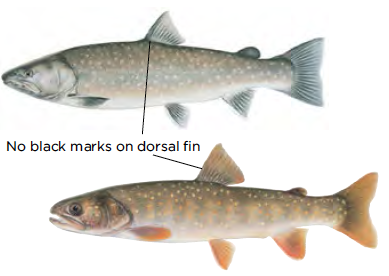
Bull Trout - NO HARVEST ALLOWED
Olive green with brown above and on sides, shading to white on belly. Lacks wormlike markings as in BROOK TROUT. Upper body with yellow spots, sides with red or orange spots. No bluish halos around spots and white borders on fins less distinct than in BROOK TROUT. Tail is slightly forked.
NATIVE.
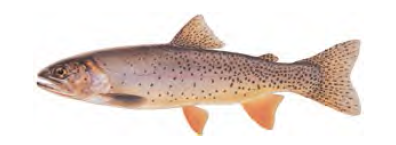
Cutthroat Trout
Red to orange slashes on underside of lower jaw. Body color variable. Back steel gray to olive green. Sides may be yellow brown with red or pink along belly. Spotting more closely grouped toward tail. May spawn in wild with rainbow. NATIVE.
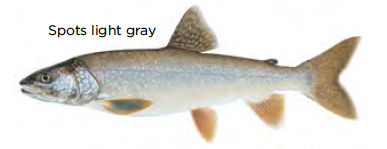
Lake Trout (Mackinaw)
Dark gray or gray green above, belly light gray to white. Irregular shaped light gray spots on back, sides, dorsal fin and tail. Pink or blue spots ABSENT. White borders on fins less distinct than in BROOK TROUT. Tail deeply forked. Inhabits only large, deep lakes. INTRODUCED
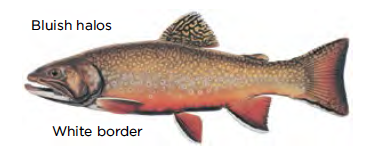
Brook Trout
Dark green or blue black on back, to white on belly. Belly and lower fins may turn brilliant red in spawning males. Upper body and dorsal fin with mottled or wormlike markings. Sides with pale spots and reddish spots which may have bluish rings around them. Lower fins, including tail. Have distinct white leading edge. Tail square, or only slightly forked. INTRODUCED.

Rainbow Trout
Body color variable. May be silvery in lakes and reservoirs. Back olive to greenish blue, belly white to silvery. Sides may show red or pink streak, white tip on pelvic (belly) and anal fin usually evident. Irregular spots on back, sides, head, dorsal fin and tail. Spots are more evenly distributed from head to tail on rainbow trout than cutthroat trout. NATIVE.

Brown Trout
Back brown or olive with large black spots. Sides light brown to yellowish with numerous brown, black and red spots surrounded by halos of blue gray. Adipose fin usually with orange border. Few, if any, spots on tail. Tail slightly forked. INTRODUCED.
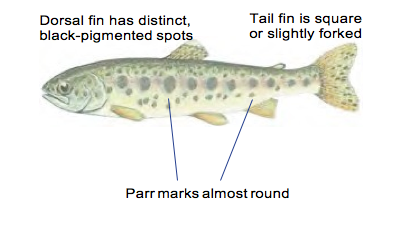
Juvenile Rainbow Trout/Steelhead
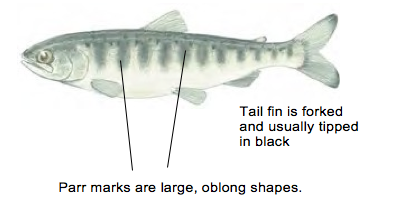
Juvenile Chinook Salmon NO HARVEST ALLOWED
In waters with ocean-going salmon or steelhead
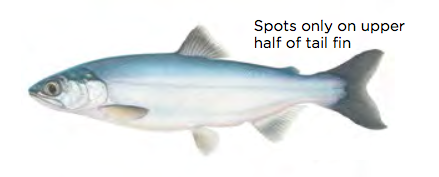
Kokanee (Blueback)
Back greenish blue with faint speckling and few if any spots. Sides and belly silvery. No distinct spotting in dorsal fin or tails as in RAINBOW. During spawning (September- December in both streams and shoreline gravels), bodies become ‘leathery’ and turn dark red to bright scarlet and heads dusky green. Spots are visible on the back half of the fish when in spawning coloration. Kokanee are native to the Payette lakes and the Stanley Basin lakes and have been established in other large lakes and reservoirs throughout the state. NATIVE.
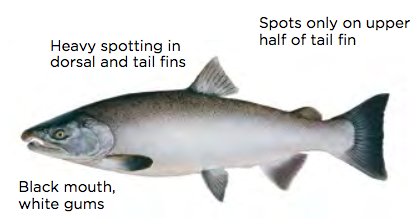
Coho Salmon
Appearance similar to kokanee with spotting on back, dorsal and upper lobe of tail fin. Sharp teeth on tongue and roof of mouth. 14-16 rays in anal fin. Can be confused with rainbow trout in reservoirs. Chinook salmon can be distinguished from coho by black inside of mouth and gums, while coho have white or gray gums. INTRODUCED.
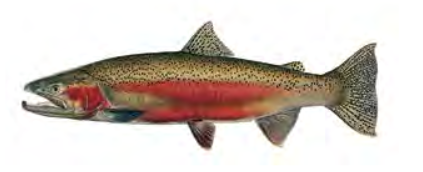
Adult Steelhead
Adults generally 20-40 inches in length. Irregularly shaped black spots on back, dorsal fin and tail. STEELHEAD are ocean-run rainbow which spawn in Snake, Clearwater and Salmon drainages; juveniles migrate to the ocean, return as adults after 1-2 years. NATIVE.
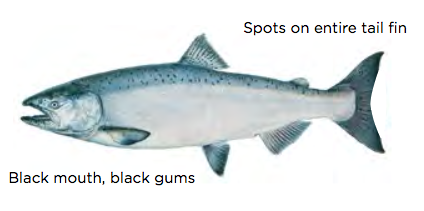
Adult Chinook Salmon
Adults 24-40 inches in length. Irregularly shaped black spots on back, dorsal fin and tail. Teeth well developed. Black mouth and gum line. Adults return to Snake, Salmon and Clearwater rivers to spawn after 1-3 years at sea. Juveniles migrate to ocean after 18 months in streams. NATIVE.

Sockeye Salmon
An anadromous (ocean going) relative of kokanee salmon. Non-spawning color is silver to steel blue. Males turn a bright red on the back and a darker red on the sides at spawning time. Females also turn red, but the red on the sides is somewhat darker. Sockeye typically spend two years in freshwater and one year in the ocean before returning to spawn in Idaho. NATIVE.
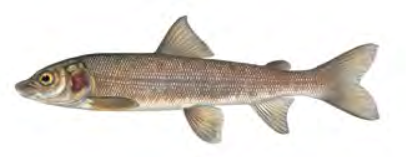
Mountain Whitefish
Color light grayish blue on back; silvery on sides; and dull whitish on belly. Small mouth without teeth. Five other species of whitefish are found in Idaho. NATIVE.
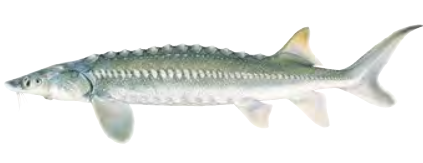
White Sturgeon NO HARVEST ALLOWED
Five rows of bony plates or scutes; mouth directed downward; four barbels in front of mouth; size up to 10 feet in Snake, Salmon and Kootenai rivers. NATIVE.

Tiger Muskie
A sterile hybrid cross of a northern pike and a muskellunge. Olive green to dark gray color with VERTICAL MARKINGS on sides. INTRODUCED.

Northern Pike
Bluish-green to gray on back and sides with irregular rows of light-colored HORIZONTAL SPOTS on sides. INTRODUCED.
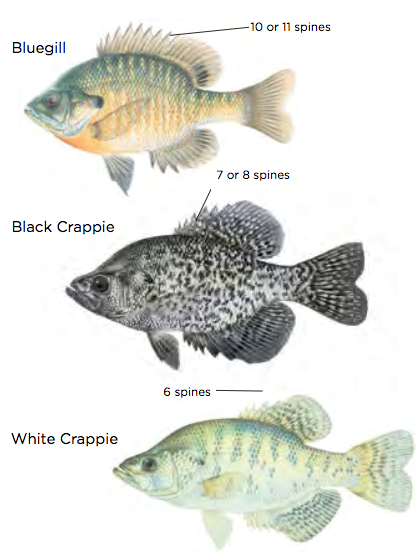
Bluegill and Crappie
Have spines in the dorsal fin. Bluegill have a blue spot on the gill cover, the back is olive to dark green with a bluish luster, sides are bluish, belly is yellowish. Crappie are grayish to silvery green on the head, with lighter sides and a silvery- white belly. Heavy black spotting or splotches on body and fins. INTRODUCED.
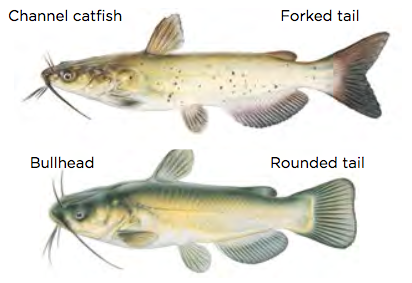
Channel Catfish and Bullhead
MEMBERS of the catfish family have 4 pairs of barbels (whiskers), spines on their dorsal and pectoral fins, and no scales. Bullheads in Idaho are normally a more solid brown. INTRODUCED.

Largemouth Bass
Dark green on back and sides, belly white. Dark, irregular HORIZONTAL band along sides. Upper jaw, when closed, extends behind the eye. INTRODUCED.
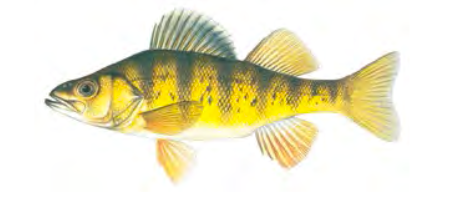
Yellow Perch
Dark green back and yellow sides with 6 to 8 dark vertical bars. Front fin has sharp spines and cheek has serrated edges. INTRODUCED.
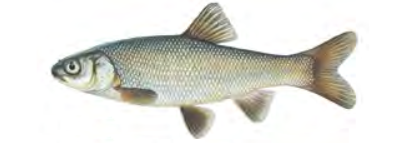
Utah Chub
Body color is black to olive brown on back with yellowish sides and a silvery to white belly. Typically has a plump body and a small mouth. Average length 8-12 inches. Found in the Bear River and Upper Snake River drainage. NATIVE.
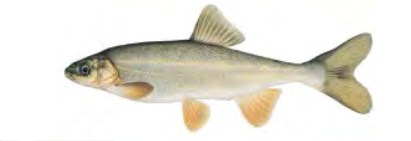
Chiselmouth
Body color is dark grayish brown on back with lighter sides and a grayish white belly. Head is blunt, snout rounded, lower lip is curved with a hard cartilage that has a straight cutting edge (like a chisel). Average length 8-10 inches. Typically found in Snake River and impoundments from Boise to Lewiston. NATIVE.
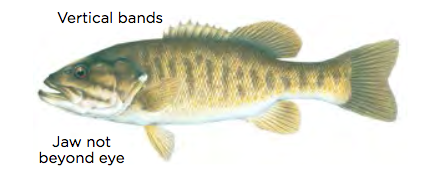
Smallmouth Bass
Dark olive to brown on back, sides bronze, belly white. Dark VERTICAL bands on sides. Eyes reddish. Upper jaw, when closed, does NOT EXTEND behind eye. INTRODUCED.
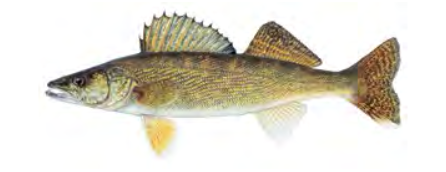
Walleye
Closely related to the yellow perch, but lacks vertical bars and has prominent “canine” teeth. Lower lobe of tail fin is white tipped. INTRODUCED.
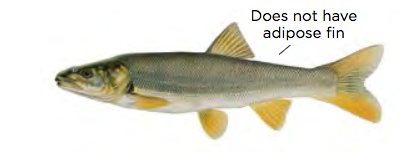
Northern Pikeminnow (formerly the northern squawfish)
Body color has a general yellowish tone, back is dark olive green, sides are grayish-silver, belly is yellowish-white. Tail fin is distinctly forked, the mouth is large. Fins without spots. NATIVE.
